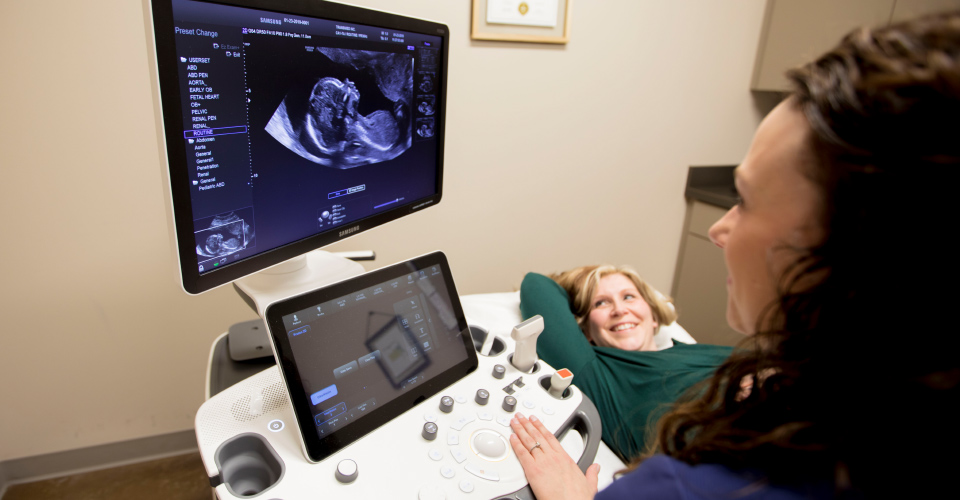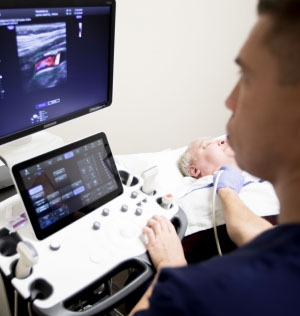OB/GYN Ultrasound
OB
OB ultrasound examination, also known as obstetric ultrasound, is the most well-known use of sonography. OB ultrasound examinations assess and provide insight into the health of an expectant mother and the development of her unborn baby (fetus). By having an ultrasound performed, the mother and her unborn baby can receive necessary care for a their pregnancy and birth.
During an obstetric ultrasound exam, one of our sonographers will use a transducer to direct sound waves, thus creating images for evaluating the anatomy of the baby. Since ultrasound technology uses sound waves to create images, obstetric ultrasound exams are typically painless and pose no known threat or harm for the patient or their baby. OB ultrasound exams are important for evaluating the health and development of a patient’s baby. The movement of the baby is monitored during the exam, and the heart beat is measured to aid in determining the baby’s wellbeing.
Providing obstetric ultrasound examinations is an exciting event. Our team of sonographers enjoy helping parents see their child for the first time, hearing their heartbeat, and determining their baby’s sex. The results from obstetric ultrasound exams are shared with a patient’s care provider, which serves as a necessary aid for care during a woman’s pregnancy.
At Transmed, we know how important OB ultrasound exams are. We take great pride in our work, always striving to provide your healthcare provider with the information needed to aid them during your prenatal care. Our team of sonographers also work hard to enhance your ultrasound experience through their sensitivity and caring attitude. They focus on making these exams as exciting and comfortable as possible.
If you or your loved one need an OB ultrasound examination, contact our office to set up an appointment. Results from your exam will be shared with your care provider in a timely manner. At Transmed, we provide quality, comfortable ultrasound exams that offer care providers quick results.
GYN
Pelvic Ultrasound can sometimes be referred to as a Gynecologic Ultrasound, Pelvic scan, Lower abdominal ultrasound, Transabdominal Ultrasound, Transvaginal Ultrasound, or Endovaginal Ultrasound. By using sound waves to create images, the technologist is able to evaluate the female pelvic organs such as the uterus, endometrium (lining of the uterus), cervix, vagina, and adnexal regions (fallopian tubes, and ovaries).
There are two methods of performing a Pelvic Ultrasound:
- Transabdominal pelvic ultrasound
- This is where a transducer or probe is placed over the lower abdomen/pelvis to view the pelvic organs and structures. This exam requires the patient to have a full bladder.
- Transvaginal (TV) ultrasound
- This ultrasound is done with a transducer (probe) which is specifically designed for insertion into the vagina. For your safety, a probe cover (or sheath) with a lubricant covers the portion of the probe that is inserted into the vagina. These probes go through a High-level Disinfection process after each use. A transvaginal ultrasound is typically done to obtain more detailed images of the pelvic organs. This ultrasound exam is done with an empty bladder.
Often it is necessary to perform both methods in order to provide the information needed for a more complete diagnosis and ultimately treatment.
Why would my healthcare provider order a pelvic ultrasound?
For women, a pelvic and/or a transvaginal ultrasound exam is ordered for a variety of medical reasons such as:
- Pelvic pain.
- Assess the uterus for growths like fibroids which are common and are almost always benign (non-cancerous).
- Locate an intrauterine device (IUD).
- To look for tumors and or cysts.
- Ovarian torsion, this is a condition that occurs when an ovary twists around its supporting tissue and blood flow is cut off.
- To look for causes for abnormal bleeding.
- Postmenopausal bleeding.
- To check for an infection (Pelvic Inflammatory Disease) in your uterus, cervix, fallopian tubes, or ovaries.
- Evaluate for fertility issues.
- Ectopic pregnancy. This is where a fertilized egg implants in your fallopian tube (tubal pregnancy) or somewhere else in your abdomen.
- Identifying an early pregnancy.
Can men have a pelvic ultrasound?
Yes, however the goal is much different. In men, a pelvic (or lower abdominal) ultrasound may be ordered to evaluate the:
- Prostate gland
- Bladder



